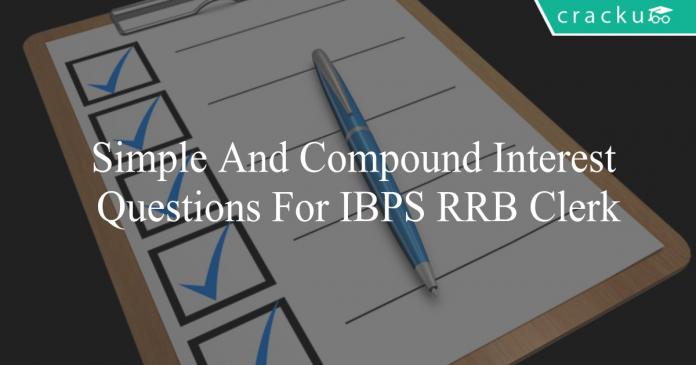Simple And Compound Interest Questions For IBPS RRB Clerk
Download Top-20 IBPS RRB Clerk Simple And Compound Questions PDF. Simple And Compound questions based on asked questions in previous year exam papers very important for the IBPS RRB Assistant exam
Download Simple & Compound Interest Questions For IBPS RRB Clerk
35 IBPS RRB Clerk Mocks @ Rs. 149
70 IBPS RRB (PO + Clerk) Mocks @ Rs. 199
Take a free mock test for IBPS RRB Clerk
Download IBPS RRB Clerk Previous Papers PDF
Instructions
Calculate the quantity I and the quantity II on the basis of the given information then compare them and answer the following questions accordingly.
Question 1: Quantity 1: Simple interest charged by a bank on a sum of Rs. 1000 at the rate of 22% annum for 2 years.
Quantity 2: Compound interest charged by another bank on a sum of Rs. 1000 at the rate of 20% annum for 2 years compounded annually.
a) Quantity 1 > Quantity 2
b) Quantity 1 $\geq$ Quantity 2
c) Quantity 1 < Quantity 2
d) Quantity 1 $\leq$ Quantity 2
e) Quantity 1 = Quantity 2
Question 2: If the difference in compound interest and simple interest at 20% per annum in two years for certain sum is 80. Then find the difference in the compound and simple interest on the same sum at 10% annum after 3 years?
a) 60
b) 68
c) 75
d) 62
e) 55
Question 3: The difference between the compound interest and simple interest on a sum for a period of 3 years at 20% per annum is Rs. 256. What is the principal amount?
a) 3000
b) 2000
c) 4000
d) 5000
e) None of these
Question 4: Mahesh borrows a certain sum from a moneylender at 10% p.a. simple interest. He lends the amount at 10% p.a. compound interest for a period of 3 years. He earns Rs.527 in the process. How much did Mahesh owe the moneylender by the end of 3 years?
a) Rs.17,000
b) Rs.18,000
c) Rs.22,100
d) Rs.21,000
e) Rs.34,000
Question 5: The difference between the compound interest and simple interest on a sum for a period of 2 years at 13% per annum is Rs. 2197. What is the principal?
a) Rs.2,60,000
b) Rs.75,000
c) Rs.1,50,000
d) Rs.1,30,000
e) Rs.1,19,000
Question 6: Daniel borrowed a certain sum at simple interest at some rate and lent it at the same rate but charged compound interest. He lent the amount for a period of 2 years. If the rate of interest is 10%, what is Daniel’s profit as a percentage of the total amount he has to repay (simple interest)?
a) 1%
b) 10%
c) 0.833%
d) 8.33%
e) 0.5%
Question 7: If the rate of return increases by 2%, the simple interest received on a certain principal increases by Rs.20 . If the time period increases by 2 years, the simple interest on the same sum increases by Rs. 100. What is the interest for 1 year?
a) 400
b) 200
c) 1000
d) 50
e) 100
Question 8: A bank offers a simple interest of 10% p.a on a sum of 15000 for two years. What is the difference in interests, if the bank offered compound interest instead?
a) 200
b) 150
c) 300
d) 2000
e) 350
Question 9: Amit deposited a certain sum in a bank which offers a simple interest of 10 % semi annually. At the end of 2 years, he got the final amount as Rupees x. If he had deposited the same amount in another bank which was offering a simple interest at the rate of 16 % per annum then the final amount would have been Rupees 960 less. Find the amount invested by him in the bank.
a) 15000
b) 18000
c) 12000
d) 10000
e) 9000
Question 10: What will be the difference between the simple and compound interests on a sum of Rs. 7000 at 10% p.a. for 2 years compounded annually?
a) Rs. 60
b) Rs. 70
c) Rs. 80
d) Rs. 90
e) Rs. 100
Free Mock Test for IBPS RRB Clerk
IBPS RRB Clerk Previous Papers
Question 11: Compound interest on a certain sum for 3 years is Rs 2880 and for 4 years it is Rs 3456. What is the value of sum taken ?
a) Rs 5000
b) Rs10000
c) Rs 8000
d) Rs 9000
e) Rs 7000
Instructions
Calculate the quantity I and the quantity II on the basis of the given information then compare them and answer the following questions accordingly.
Question 12: Quantity 1: Simple interest charged by a bank on a sum of Rs. 1000 at the rate of 22% annum for 2 years.
Quantity 2: Compound interest charged by another bank on a sum of Rs. 1000 at the rate of 20% annum for 2 years compounded annually.
a) Quantity 1 > Quantity 2
b) Quantity 1 $\geq$ Quantity 2
c) Quantity 1 < Quantity 2
d) Quantity 1 $\leq$ Quantity 2
e) Quantity 1 = Quantity 2
Question 13: If the difference in compound interest and simple interest at 20% per annum in two years for certain sum is 80. Then find the difference in the compound and simple interest on the same sum at 10% annum after 3 years?
a) 60
b) 68
c) 75
d) 62
e) 55
Question 14: The difference between the compound interest and simple interest on a sum for a period of 3 years at 20% per annum is Rs. 256. What is the principal amount?
a) 3000
b) 2000
c) 4000
d) 5000
e) None of these
Question 15: Krishna borrows Rs. 10,000 from a bank at 10% per annum compounded annually. He returned the sum in 2 equal installments at the end of first year and second year. Find out the amount he paid in each installment?
a) 5500
b) 5671.90
c) 6000
d) 5761.90
e) 5840.90
Question 16: Rohit borrowed a certain sum from a bank at 10% per annum compounded annually. He invested this amount in mutual funds. After two years, he got 30% return on his investment. If he is left with Rs. 900 after clearing bank’s dues. Figure out the amount that Rohit borrowed from the bank?
a) 15000
b) 20000
c) 10000
d) 100000
e) None of the above.
Question 17: Mahesh borrows a certain sum from a moneylender at 10% p.a. simple interest. He lends the amount at 10% p.a. compound interest for a period of 3 years. He earns Rs.527 in the process. How much did Mahesh owe the moneylender by the end of 3 years?
a) Rs.17,000
b) Rs.18,000
c) Rs.22,100
d) Rs.21,000
e) Rs.34,000
Question 18: The difference between the compound interest and simple interest on a sum for a period of 2 years at 13% per annum is Rs. 2197. What is the principal?
a) Rs.2,60,000
b) Rs.75,000
c) Rs.1,50,000
d) Rs.1,30,000
e) Rs.1,19,000
Question 19: Ram borrows Rs. 50,000 from Arun compounded half yearly at 20% per annum. The interest for a period of 2 years will be
a) Rs. 22,000
b) Rs. 73,205
c) Rs. 23,205
d) Rs. 22,205
e) Rs. 72,205
Question 20: Daniel borrowed a certain sum at simple interest at some rate and lent it at the same rate but charged compound interest. He lent the amount for a period of 2 years. If the rate of interest is 10%, what is Daniel’s profit as a percentage of the total amount he has to repay (simple interest)?
a) 1%
b) 10%
c) 0.833%
d) 8.33%
e) 0.5%
Quantitative Aptitude formulas PDF
520 Banking Mocks – Just Rs. 499
Answers & Solutions:
1) Answer (E)
Simple interest paid to bank = 1000*.22*2 = Rs. 440
Compound interest paid to bank = $1000(1 + \dfrac{20}{100})^2 – 1000$ = Rs. 440
Hence, we can say that Quantity 1 = Quantity 2. Option E is the correct answer.
2) Answer (D)
Let us assume ‘P’ is the principal which is borrowed.
Simple interest accrued in 2 years = $\frac{P * 20 * 2}{100}$ = 0.4P
Compound interest accrued in 2 years = P *$(1 + \frac{20}{100} )^{2}$ – P = 0.44P
Difference between compound and simple interest = 0.44P – 0.4P = 0.04P
$\Rightarrow$ 80 = 0.04 P
$\Rightarrow$ P = 2000
Simple interest accrued in 3 years at 10% per annum = $\frac{2000 * 10 * 3}{100}$ = 600
Compound interest accrued in 3 years at 10% per annum = 2000 *$(1 + \frac{10}{100} )^{3}$ – 2000 = 662
So the difference in C.I. and S.I. at 10% annum after 3 years = 662-600 = 62
3) Answer (B)
Let assume the principal amount = X
Simple interest for 3 years = $\frac{Principal*Rate*Time}{100}$ = $\frac{X*20*3}{100}$ = 0.6X
Compound interest payable for 3 years = X*$(1+\frac{20}{100})^{3}$-X = 0.728X
Difference between compound and simple interest = 0.728X – 0.6X = 0.128X
$\Rightarrow$ 0.128X = 256
$\therefore$ X = 2000 (ans)
4) Answer (C)
Amount by the end of 3 years in compound interest = $p(1+r)^n$
=> Amount received by Mahesh = $p*1.1^3$
Amount received by Mahesh = $1.331p$
Amount Mahesh owes = $p+pnr$ = $p+p*3*0.1$ = $1.3p$.
Profit = $1.331p – 1.3p = 0.031p$
It has been given that $0.031p = 527$
=> $p = Rs. 17000$.
Amount that Mahesh will owe = $1.3*17000 = 22100$
Therefore, option C is the right answer.
5) Answer (D)
Difference between compound and simple interests for a period of 2 years = $\frac{pr^2}$.
Therefore, $p*0.13*0.13= 2197$
$p = 2197/0.0169$
$p = $ Rs. $1,30,000$.
Therefore, option D is the right answer.
6) Answer (C)
Let $p$ be the principal. Time period = 2 years. Let $r$ be the rate of interest.
Amount Daniel will owe by the end of 2 years = $p + 2pr$
Amount Daniel will receive by the end of 2 years = $p(1+r)^2$
= $p (1+r^2 + 2r)$
=$p + pr^2 + 2pr$.
Profit realized by Daniel = $p + pr^2 + 2pr -p – 2pr$.
=> Profit = $pr^2$
Profit percentage = $\frac{pr^2}{p+2pr}$
=$\frac{r^2}{1+2r}$
We know that rate of interest = $10$%.
=> Profit percentage = $\frac{0.01}{1.2}$ = $0.833$%.
Therefore, option C is the right answer.
7) Answer (D)
Let,
i = prt/100
Given,
i + 20 = p * (r+2) * t /100
or pr = 5000
We know that the interest for 1st year = p * r * 1/100 = 5000/100 = 50
8) Answer (B)
SI = PRT/100
SI = 15000 * 2 * 0.1 = 3000
In CI,
$A = p(1 + (r/100))^2$
A = 15000 * 1.21
CI = 15000 * .21 = 3150
Difference = 150
9) Answer (C)
Let the initial amount deposited by him be ‘P’. Hence, the interest earned on it in first case will be
P*10*4/100 = .4P ( The interest is calculated semi annually. Hence, there are 4 time periods).
In second case, the interest earned will be
P*16*2/100 = .32P
We have been given that
.4P – .32P = .08P
We have been given that
.08P = 960
=> P = 12000
Thus, option C is the correct answer.
10) Answer (B)
Difference between the interests = Amount due to CI – Amount due to SI
Amount due to CI = $p(1+\frac{r}{100})^n$ = $p(1.1)^2$
= $7000 * 1.21$
= Rs. $8470$
Amount due to SI = $p + \frac{pnr}{100}$
= $7000 + \frac{7000*10*2}{100}$
= $7000 + 1400$
= Rs. $8400$.
Difference between the interests = Rs. $8470$ – Rs.$8400$
= Rs. $70$
Hence, option B is the right answer.
11) Answer (B)
Let R%=r
Given $ Pr(1+r)^{2}$=2880
$ Pr(1+r)^{3}$=3456
Dividing both the equations we have
1/(1+r)=5/6
6=5+5r
r=1/5
R=(1/5)*100
R=20%
Therefore $P(1/5)(1+(1/5))^{2}$=2880
P(36/125)=2880
P=2880*125/36
P=Rs 10000
12) Answer (E)
Simple interest paid to bank = 1000*.22*2 = Rs. 440
Compound interest paid to bank = $1000(1 + \dfrac{20}{100})^2 – 1000$ = Rs. 440
Hence, we can say that Quantity 1 = Quantity 2. Option E is the correct answer.
13) Answer (D)
Let us assume ‘P’ is the principal which is borrowed.
Simple interest accrued in 2 years = $\frac{P * 20 * 2}{100}$ = 0.4P
Compound interest accrued in 2 years = P *$(1 + \frac{20}{100} )^{2}$ – P = 0.44P
Difference between compound and simple interest = 0.44P – 0.4P = 0.04P
$\Rightarrow$ 80 = 0.04 P
$\Rightarrow$ P = 2000
Simple interest accrued in 3 years at 10% per annum = $\frac{2000 * 10 * 3}{100}$ = 600
Compound interest accrued in 3 years at 10% per annum = 2000 *$(1 + \frac{10}{100} )^{3}$ – 2000 = 662
So the difference in C.I. and S.I. at 10% annum after 3 years = 662-600 = 62
14) Answer (B)
Let assume the principal amount = X
Simple interest for 3 years = $\frac{Principal*Rate*Time}{100}$ = $\frac{X*20*3}{100}$ = 0.6X
Compound interest payable for 3 years = X*$(1+\frac{20}{100})^{3}$-X = 0.728X
Difference between compound and simple interest = 0.728X – 0.6X = 0.128X
$\Rightarrow$ 0.128X = 256
$\therefore$ X = 2000 (ans)
15) Answer (D)
Let us assume Krishna paid x rupees in each instalment then at the end of first year
Principal amount = 10000, Interest payable = $\frac{10}{100}*10000$ = 1000
Principle amount left for second year = total payable at end of first year – instalment amount
$\Rightarrow$ 10000+1000 – x = 11000 – x
Taking second year into consideration
Interest payable = $\frac{10}{100}*(11000 – x)$ = 1100 – 0.1x
So second instalment = Principal amount + interest = x
$\Rightarrow$ (11000 – x) + (1100 – 0.1x) = x
$\Rightarrow$ 12100 = 2.1x
$\Rightarrow$ x = 5761.90
Hence we can say that Krishna paid 5761.90 rupees in each instalment.
16) Answer (C)
Let assume Rohit borrowed amount X from the bank.
Return on investment = 30%
Total money accumulated after 2 years =$\frac{100+30}{100} * X$ = 1.3X
The amount that Rohit owed to bank = $X * (1+\frac{10}{100})^{2}$
= 1.21X
So, Rohit’s net profit in this entire transaction = 1.30X-1.21X = 0.09X
$\therefore$ 0.09X = 900
X = 10000
Hence, we can say that Rohit borrowed Rs. 10000 from the bank.
17) Answer (C)
Amount by the end of 3 years in compound interest = $p(1+r)^n$
=> Amount received by Mahesh = $p*1.1^3$
Amount received by Mahesh = $1.331p$
Amount Mahesh owes = $p+pnr$ = $p+p*3*0.1$ = $1.3p$.
Profit = $1.331p – 1.3p = 0.031p$
It has been given that $0.031p = 527$
=> $p = Rs. 17000$.
Amount that Mahesh will owe = $1.3*17000 = 22100$
Therefore, option C is the right answer.
18) Answer (D)
Difference between compound and simple interests for a period of 2 years = $\frac{pr^2}$.
Therefore, $p*0.13*0.13= 2197$
$p = 2197/0.0169$
$p = $ Rs. $1,30,000$.
Therefore, option D is the right answer.
19) Answer (C)
The amount has been borrowed at 20% p.a. and is compounded every half year.
Therefore, time period = 2*2 = 4 and effective interest rate = 20/2 = 10% p.a.
Amount = $p(1+\frac{r}{100})^2$
= $50,000*(1.1)^4$
= Rs. $73,205$
Interest = Rs. $73,205$ – Rs. $50,000$.
= Rs.$23,205$.
Therefore, option C is the right answer.
20) Answer (C)
Let $p$ be the principal. Time period = 2 years. Let $r$ be the rate of interest.
Amount Daniel will owe by the end of 2 years = $p + 2pr$
Amount Daniel will receive by the end of 2 years = $p(1+r)^2$
= $p (1+r^2 + 2r)$
=$p + pr^2 + 2pr$.
Profit realized by Daniel = $p + pr^2 + 2pr -p – 2pr$.
=> Profit = $pr^2$
Profit percentage = $\frac{pr^2}{p+2pr}$
=$\frac{r^2}{1+2r}$
We know that rate of interest = $10$%.
=> Profit percentage = $\frac{0.01}{1.2}$ = $0.833$%.
Therefore, option C is the right answer.





